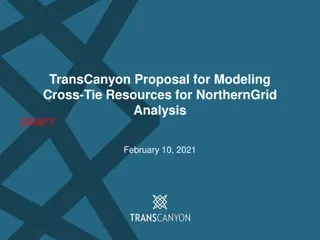Proposal to Enhance Qualifying Capacity Calculation for Pre-Dispatch Resources
PG&E has proposed a modification to the Qualifying Capacity calculation for pre-dispatch resources, aiming to base the NQC on economic bids and self-schedules rather than CAISO-scheduled MWs. This adjustment would better reflect the value of capacity offered by various facilities, encourage economic bidding, enhance operational flexibility, prevent over-procurement, and reduce costs for customers.
Download Presentation

Please find below an Image/Link to download the presentation.
The content on the website is provided AS IS for your information and personal use only. It may not be sold, licensed, or shared on other websites without obtaining consent from the author.If you encounter any issues during the download, it is possible that the publisher has removed the file from their server.
You are allowed to download the files provided on this website for personal or commercial use, subject to the condition that they are used lawfully. All files are the property of their respective owners.
The content on the website is provided AS IS for your information and personal use only. It may not be sold, licensed, or shared on other websites without obtaining consent from the author.
E N D
Presentation Transcript
PG&E Proposals for Refinements to the Resource Adequacy (RA) Program Compliance Year 2017 RA Workshop February 18, 2016 1
PG&E Proposal to Modify the Qualifying Capacity (QC) Calculation for Pre-Dispatch Resources The 2016 RA decision adopted by the Commission directed that QCs for QF cogeneration resources be based on the amount the facility is able to schedule in the day ahead market. This may undervalue the capacity that is being made available to the CAISO because, due to resource economics, the resource could be scheduled by CAISO at an amount lower than the amount bid in. The decision narrowly applies to QF cogeneration resources. A broader application for all pre-dispatch resources would provide greater benefits to the grid and better value to customers. Problem Statement The Commission should calculate the NQC of pre-dispatch resources based on submitted economic bids and self-schedules for resources instead of CAISO-scheduled MWs. The Commission should expand the scope of last year s proposal to apply not only to QF cogeneration facilities, but also to biomass, biogas and cogeneration facilities that are not QFs. Proposed Solution Appropriately recognizes the value of capacity offered by all cogeneration facilities to the CAISO market. Encourages economic bidding of resources, thereby providing more operational flexibility to the CAISO. Helps prevent over-procurement. Reduces costs to customers. Justification for Proposal 3
Illustrative Impact of Economic Bidding on a Cogeneration Resource s Qualifying Capacity 2012: Market Prices and Resultant Dispatch for Hypothetical Cogen Resource 2015: Market Prices and Resultant Dispatch for Hypothetical Cogen Resource Bid at P-max 50 50 45 45 40 40 35 35 Price ($/MWh) Price ($/MWh) 30 30 25 25 20 20 15 15 10 10 5 5 0 0 1 3 5 7 9 11 13 15 17 19 21 23 Hour 1 3 5 7 9 11 13 15 17 19 21 23 Hour Scheduled for 13 hours Scheduled for 10 hours Market Clearing Price Unit Bid Price Market Clearing Price Unit Bid Price Calculating the QC based on historic CAISO schedules may penalize a resource that provides operational flexibility to the grid through economic bidding or self-scheduling only at times where the resource is economic In both examples above, the resource offers its full P-max into the day-ahead market However, the resource is scheduled for fewer hours in 2015 compared to 2012, due to lower mid-day prices 4
Flexible Capacity Requirements Allocation 5
PG&E Proposal to Modify the CPUCs Flexible RA Requirements Allocation Methodology The current CPUC methodology used in allocating flexible RA requirements does not reflect cost causation because it is based on a load-serving entity s (LSE) load ratio share rather than its contribution to the system s largest 3-hour ramps. Problem Statement The Commission should modify the methodology for allocating flexible RA requirements to its LSEs so that the flexible RA requirements are allocated in proportion to the LSEs contribution to the CAISO s monthly net- load ramps. Proposed Solution Better reflects cost causation. Aligns the Commission s and the CAISO s allocation approaches. Sends better market signals to developers and LSEs. Justification for Proposal 6
Flexible RA Allocation and Cost Causation CAISOAllocation Methodology CPUC Allocation Methodology Based on peak load ratio share (consistent with allocation of system and local RA requirements) Based on contribution to the maximum three-hour net load ramp Flexible Capacity Need* Total Flexible Capacity Requirement Load Wind Solar PV Solar Thermal + 3.5% x Expected Peak x Peak Load Ratio Share Obligation=LSE Coincident Peak Load ISO Coincident Peak Load LSE x = Allocating flexible RA requirements based on net load ramp contributions instead of peak load ratio share accomplishes the following: Fairness and cost causation: Reflects an individual LSE s contribution to ramping needs Correct market signals: Incentivizes LSEs to reduce ramping needs Regulatory consistency: Aligns CPUC and CAISO allocation methodologies * The delta in each of these terms represents the average percent contribution during the top five greatest 3-hour ramps. For load, this calculation uses historical data. For renewable generation, this calculation uses forecasted data. 7























